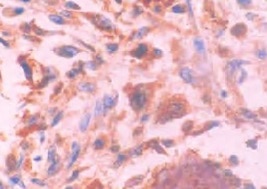Human/Rat Osteocalcin Antibody Summary
YLYQWLGAPVPYPDPLEPRREVCELNPDCDELADHIGFQEAYRRFYGPV
Accession # P02818
Applications
Please Note: Optimal dilutions should be determined by each laboratory for each application. General Protocols are available in the Technical Information section on our website.
Scientific Data
 View Larger
View Larger
Osteocalcin in MG‑63 Human Cell Line. Osteocalcin was detected in immersion fixed MG-63 human osteosarcoma cell line using Mouse Anti-Human/Rat Osteocalcin Monoclonal Antibody (Catalog # MAB1419) at 10 µg/mL for 3 hours at room temperature. Cells were stained using the NorthernLights™ 557-conjugated Anti-Mouse IgG Secondary Antibody (red; Catalog # NL007) and counterstained with DAPI (blue). View our protocol for Fluorescent ICC Staining of Cells on Coverslips.
 View Larger
View Larger
Osteocalcin in Human Osteocytes. Osteocalcin was detected in human mesenchymal stem cells differentiated into osteocytes using Mouse Anti-Human/Rat Osteocalcin Monoclonal Antibody (Catalog # MAB1419) at 10 µg/mL for 3 hours at room temperature. Cells were stained using the NorthernLights™ 557-conjugated Anti-Mouse IgG Secondary Antibody (red; Catalog # NL007) and counterstained with DAPI (blue). View our protocol for Fluorescent ICC Staining of Cells on Coverslips.
 View Larger
View Larger
Osteocalcin in Rat Osteocytes. Osteocalcin was detected in immersion fixed rat osteocytes differentiated from mesenchymal stem cells using Mouse Anti-Human/Rat Osteocalcin Monoclonal Antibody (Catalog # MAB1419) at 10 µg/mL for 3 hours at room temperature. Cells were stained using the NorthernLights™ 557-conjugated Anti-Mouse IgG Secondary Antibody (red; Catalog # NL007) and counterstained with DAPI (blue). View our protocol for Fluorescent ICC Staining of Cells on Coverslips.
 View Larger
View Larger
Osteocalcin in Human Cartilage. Osteocalcin was detected in immersion fixed paraffin-embedded sections of human cartilage using Mouse Anti-Human/Rat Osteocalcin Monoclonal Antibody (Catalog # MAB1419) at 8 µg/mL overnight at 4 °C. Tissue was stained using the Anti-Mouse HRP-DAB Cell & Tissue Staining Kit (brown; Catalog # CTS002) and counterstained with hematoxylin (blue). Specific labeling was localized to the cytoplasm of chondrocytes. View our protocol for Chromogenic IHC Staining of Paraffin-embedded Tissue Sections.
 View Larger
View Larger
Osteocalcin in Human Osteosarcoma. Osteocalcin was detected in immersion fixed paraffin-embedded sections of human osteosarcoma using Mouse Anti-Human/Rat Osteocalcin Monoclonal Antibody (Catalog # MAB1419) at 25 µg/mL overnight at 4 °C. Tissue was stained using the Anti-Mouse HRP-DAB Cell & Tissue Staining Kit (brown; Catalog # CTS002) and counterstained with hematoxylin (blue). View our protocol for Chromogenic IHC Staining of Paraffin-embedded Tissue Sections.
 View Larger
View Larger
Detection of Osteocalcin in Saos‑2 Human Cell Line by Flow Cytometry. Saos-2 human osteosarcoma cell line was stained with Mouse Anti-Human/Rat Osteocalcin Monoclonal Antibody (Catalog # MAB1419, filled histogram) or isotype control antibody (Catalog # MAB002, open histogram), followed by Allophycocyanin-conjugated Anti-Mouse IgG Secondary Antibody (Catalog # F0101B). To facilitate intracellular staining, cells were fixed with paraformaldehyde and permeabilized with saponin.
 View Larger
View Larger
Detection of Osteocalcin in Human Osteoblasts by Flow Cytometry. Human osteoblasts were stained with Mouse Anti-Human/Rat Osteocalcin Monoclonal Antibody (Catalog # MAB1419, filled histogram) or isotype control antibody (Catalog # MAB002, open histogram), followed by Allophycocyanin-conjugated Anti-Mouse IgG Secondary Antibody (Catalog # F0101B). To facilitate intracellular staining, cells were fixed with paraformaldehyde and permeabilized with saponin.
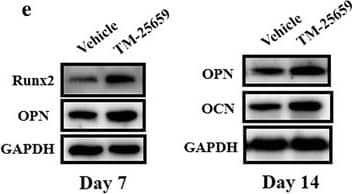 View Larger
View Larger
Detection of Human Osteocalcin by Western Blot Exposure of TAZ activator TM-25659 promotes osteogenic differentiation of ADSCs in vitro. a Cell viability was determined after ADSCs were cultured with diverse concentrations of TM-25659 (0–50 μM) at 24 h and 48 h, respectively. B Enhanced osteogenic differentiation of ADSCs was detected and quantified by alkaline phosphatase (ALP) activity assay following ADSC culture with osteoinductive medium and TM-25659 at day 7. c, d Increased mineralization in ADSCs cultured in osteoinductive medium and TM-25659 was observed and quantified via Alizarin Red staining at days 7 and 14. Scale bar = 50 μm. e Significantly increased expression of the osteogenic markers runt-related transcription factor 2 (Runx2), osteopontin (OPN), and osteocalcin (OCN) was observed in ADSCs cultured in osteoinductive medium and TM-25659 at days 7 and 14, respectively. Representative images of Western blots from three independent experiments are shown. Data shown here are mean ± SD from three independent experiments; **P < 0.01, by Student’s t test. GAPDH glyeraldehyde-3-phosphate dehydrogenase, OD optical density Image collected and cropped by CiteAb from the following publication (https://pubmed.ncbi.nlm.nih.gov/29514703), licensed under a CC-BY license. Not internally tested by R&D Systems.
 View Larger
View Larger
Detection of Human Osteocalcin by Immunocytochemistry/Immunofluorescence Nano-fiber plugs induce osteogenesis of human MSCs.Healthy donor-derived MSCs were seeded onto plastic plates (A-C) or injected into the nano-fiber plugs (D-I), and then cultured in MSCGM for 1 day (D), 7 days (E, G), 14 days (F, H) and 28 days (A-C, I). Then, the expression levels of RUNX2 (A, D, G), osteocalcin (B, E, H), and DMP-1 (C, F, I) were evaluated immunohistochemically. Representative results of three experiments are shown. (J) Healthy donor-derived MSCs were cultured in MSCGM onto plastic plates (two-dimensional) or nano-fiber plugs (three-dimensional) for 28 days. After RNA extraction, MEPE expression in the 4 groups of healthy donor-derived MSCswas evaluated by real-time PCR. *p<0.05 vs. two-dimensional culture by paired t-test. Scale bars, 50 μm. Image collected and cropped by CiteAb from the following publication (https://dx.plos.org/10.1371/journal.pone.0153231), licensed under a CC-BY license. Not internally tested by R&D Systems.
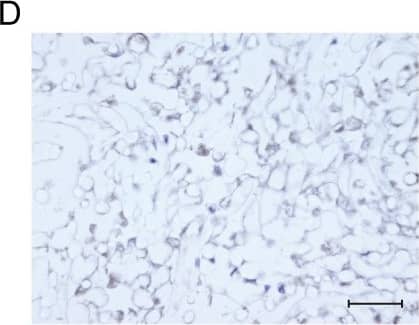 View Larger
View Larger
Detection of Human Osteocalcin by Immunocytochemistry/Immunofluorescence Nano-fiber plugs induce osteogenesis of human MSCs.Healthy donor-derived MSCs were seeded onto plastic plates (A-C) or injected into the nano-fiber plugs (D-I), and then cultured in MSCGM for 1 day (D), 7 days (E, G), 14 days (F, H) and 28 days (A-C, I). Then, the expression levels of RUNX2 (A, D, G), osteocalcin (B, E, H), and DMP-1 (C, F, I) were evaluated immunohistochemically. Representative results of three experiments are shown. (J) Healthy donor-derived MSCs were cultured in MSCGM onto plastic plates (two-dimensional) or nano-fiber plugs (three-dimensional) for 28 days. After RNA extraction, MEPE expression in the 4 groups of healthy donor-derived MSCswas evaluated by real-time PCR. *p<0.05 vs. two-dimensional culture by paired t-test. Scale bars, 50 μm. Image collected and cropped by CiteAb from the following publication (https://dx.plos.org/10.1371/journal.pone.0153231), licensed under a CC-BY license. Not internally tested by R&D Systems.
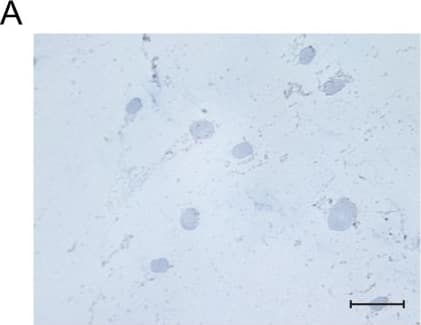 View Larger
View Larger
Detection of Human Osteocalcin by Immunocytochemistry/Immunofluorescence Nano-fiber plugs induce osteogenesis of human MSCs.Healthy donor-derived MSCs were seeded onto plastic plates (A-C) or injected into the nano-fiber plugs (D-I), and then cultured in MSCGM for 1 day (D), 7 days (E, G), 14 days (F, H) and 28 days (A-C, I). Then, the expression levels of RUNX2 (A, D, G), osteocalcin (B, E, H), and DMP-1 (C, F, I) were evaluated immunohistochemically. Representative results of three experiments are shown. (J) Healthy donor-derived MSCs were cultured in MSCGM onto plastic plates (two-dimensional) or nano-fiber plugs (three-dimensional) for 28 days. After RNA extraction, MEPE expression in the 4 groups of healthy donor-derived MSCswas evaluated by real-time PCR. *p<0.05 vs. two-dimensional culture by paired t-test. Scale bars, 50 μm. Image collected and cropped by CiteAb from the following publication (https://dx.plos.org/10.1371/journal.pone.0153231), licensed under a CC-BY license. Not internally tested by R&D Systems.
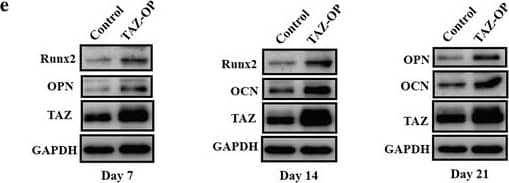 View Larger
View Larger
Detection of Human Osteocalcin by Western Blot Enforced TAZ overexpression enhances osteogenic differentiation of ADSCs in vitro. a Transcriptional coactivator with PDZ-binding motif (TAZ) overexpression (OP) in ADSCs infected with lentiviral particles containing human TAZ cDNA sequence was verified by Western blot. Representative images of Western blots from three independent experiments are shown. b Accelerated cell proliferation was detected in TAZ-overexpressing ADSCs compared with control cells infected with empty lentiviral particles via MTT assay. c Enhanced osteogenic differentiation of ADSCs was detected and quantified by alkaline phosphatase (ALP) activity assay following TAZ overexpression in ADSCs induced in vitro at day 7. d Increased mineralization in TAZ-overexpressing ADSCs cultured in osteoinductive medium was observed via Alizarin Red staining at days 7 and 14. Scale bar = 50 μm. e Significantly enhanced expression of TAZ as well as the osteogenic markers osteopontin (OPN) and osteocalcin (OCN) in TAZ-overexpressing ADSCs cultured in osteoinductive medium at days 7, 14, and 21 was detected by Western blot. Representative images of Western blots from three independent experiments are shown. Data shown here are mean ± SD from three independent experiments; #P ˃ 0.05, *P < 0.05, **P < 0.01, by Student’s t test. GAPDH glyeraldehyde-3-phosphate dehydrogenase, OD optical density, Runx2 runt-related transcription factor 2 Image collected and cropped by CiteAb from the following publication (https://pubmed.ncbi.nlm.nih.gov/29514703), licensed under a CC-BY license. Not internally tested by R&D Systems.
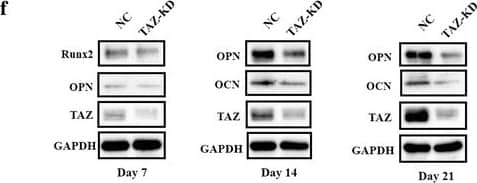 View Larger
View Larger
Detection of Human Osteocalcin by Western Blot TAZ knockdown impairs osteogenic differentiation of ADSCs in vitro. a Transcriptional coactivator with PDZ-binding motif (TAZ) knockdown (KD) in ADSCs infected with shRNA lentiviral particles targeting human TAZ was verified by Western blot. Representative images of Western blots from three independent experiments are shown. b TAZ and its downstream targets CTGF and Cyr61 were downregulated in TAZ-knockdown ADSCs as determined by quantitative RT-PCR. c Cell proliferation was compromised in TAZ-knockdown ADSCs compared with control cells infected with nontargeting lentiviral vectors with scrambled sequence. d Compromised osteogenic differentiation of ADSCs was detected and quantified by alkaline phosphatase (ALP) activity assay following TAZ knockdown of ADSCs induced in vitro at day 7. e Reduced mineralization in TAZ-knockdown ADSCs cultured in osteoinductive medium was observed via Alizarin Red staining at days 7, 14, and 21. f Significantly reduced expression of TAZ as well as the osteogenic markers osteopontin (OPN) and osteocalcin (OCN) in TAZ-knockdown ADSCs cultured in osteoinductive medium at days 7, 14, and 21 was detected by Western blot. Representative images of Western blots from three independent experiments are shown. Data shown here are mean ± SD from three independent experiments, #P ˃ 0.05, *P < 0.05, **P < 0.01, by Student’s t test. GAPDH glyeraldehyde-3-phosphate dehydrogenase, NC normal control, OD optical density, Runx2 runt-related transcription factor 2 Image collected and cropped by CiteAb from the following publication (https://pubmed.ncbi.nlm.nih.gov/29514703), licensed under a CC-BY license. Not internally tested by R&D Systems.
 View Larger
View Larger
Detection of Human Osteocalcin by Western Blot TAZ is upregulated during osteogenesis while it is downregulated during adipogenesis in human ADSCs. a Osteogenic differentiation of ADSCs was induced in vitro and monitored by Alizarin Red and von Kossa staining at the indicated time points (days 7, 14, 21, and 28 after induction). Scale bar = 50 μm. b,c Transcriptional coactivator with PDZ-binding motif (TAZ) protein was significantly increased during the osteogenic differentiation process of ADSCs, concomitant with markedly upregulated expression of the osteogenic markers runt-related transcription factor 2 (Runx2), osteopontin (OPN), and osteocalcin (OCN). Representative images of Western blots from three independent experiments are shown. d The mRNA levels of TAZ and the osteogenic markers were significantly increased during ADSC osteogenic differentiation in vitro as measured by quantitative RT-PCR. e Adipogenic differentiation of ADSCs was induced in vitro and determined by Oil Red O staining at the indicated time points (days 7, 14, and 21 after induction). Scale bar = 50 μm. f TAZ protein was significantly downregulated during the adipogenic differentiation process of ADSCs. Representative images of Western blots from three independent experiments are shown. g The mRNA levels of TAZ decreased while the adipogenic marker increased during ADSC adipogenic differentiation in vitro as measured by quantitative RT-PCR. Data shown here are mean ± SD from three independent experiments; #P ˃ 0.05, *P < 0.05, **P < 0.01, by ANOVA. ALP alkaline phosphatase, GAPDH glyeraldehyde-3-phosphate dehydrogenase, PPAR gamma peroxisome proliferator-activated receptor-gamma Image collected and cropped by CiteAb from the following publication (https://pubmed.ncbi.nlm.nih.gov/29514703), licensed under a CC-BY license. Not internally tested by R&D Systems.
 View Larger
View Larger
Detection of Rat Osteocalcin by Immunocytochemistry/Immunofluorescence In vitro differentiation capacity of young and old BM-MSCs: (A) Representative micrographs from each experimental group showing morphological change after 21 days of differentiation. (B) Results of adipogenic, osteogenic and chondrogenic differentiation. Representative micrographs showing anti-FABP4, Oil Red O, anti-osteocalcin, Alizarin Red-S and anti-aggrecan staining in cultured BM-MSCs from each experimental group. Image collected and cropped by CiteAb from the following publication (https://pubmed.ncbi.nlm.nih.gov/21992089), licensed under a CC-BY license. Not internally tested by R&D Systems.
 View Larger
View Larger
Detection of Human Osteocalcin by Immunohistochemistry TM-25659 promotes in vivo bone formation of ADSCs. a Schematic description of experimental procedure for in vivo transplantation. Adipose-derived stem cells (ASCs) were initially treated with osteoinductive medium and TM-25659 for consecutive 7 days, then harvested, seeded on porous beta -TCP blocks as a carrier, and subcutaneously transplanted into nude mice (six animals per experimental group). Six weeks later all transplants were harvested for further analysis. b Hematoxylin and eosin (H&E) and Masson trichrome staining revealed markedly enhanced bone formation in samples from ADSCs treated with TM-25659 compared with vehicle-treated samples. Scale bar = 100 μm. c Quantification of bone formation in samples indicated significantly more bone formation in ADSCs treated with TM-25659. Ten images of Masson staining (400×) were randomly selected in the slides from two experimental groups and captured under microscopy. The area of new bone in each image was marked using ImageJ and the percentage of new bone over total area was calculated. d Immunohistochemical staining of osteopontin (OPN) and osteocalcin (OCN) in samples revealed elevated OPN and OCN abundance in samples from ADSCs treated with TM-25659 compared with vehicle-treated samples. Scale bar = 100 μm. Data are shown as fold-change compared with vehicle-treated samples which were defined as 1.0. Data shown here are mean ± SD from two independent experiments; **P < 0.01, by Student’s t test. NB new bone, S scaffold Image collected and cropped by CiteAb from the following publication (https://pubmed.ncbi.nlm.nih.gov/29514703), licensed under a CC-BY license. Not internally tested by R&D Systems.
 View Larger
View Larger
Detection of Human Osteocalcin by Immunocytochemistry/Immunofluorescence Nano-fiber plugs induce osteogenesis of human MSCs.Healthy donor-derived MSCs were seeded onto plastic plates (A-C) or injected into the nano-fiber plugs (D-I), and then cultured in MSCGM for 1 day (D), 7 days (E, G), 14 days (F, H) and 28 days (A-C, I). Then, the expression levels of RUNX2 (A, D, G), osteocalcin (B, E, H), and DMP-1 (C, F, I) were evaluated immunohistochemically. Representative results of three experiments are shown. (J) Healthy donor-derived MSCs were cultured in MSCGM onto plastic plates (two-dimensional) or nano-fiber plugs (three-dimensional) for 28 days. After RNA extraction, MEPE expression in the 4 groups of healthy donor-derived MSCswas evaluated by real-time PCR. *p<0.05 vs. two-dimensional culture by paired t-test. Scale bars, 50 μm. Image collected and cropped by CiteAb from the following publication (https://dx.plos.org/10.1371/journal.pone.0153231), licensed under a CC-BY license. Not internally tested by R&D Systems.
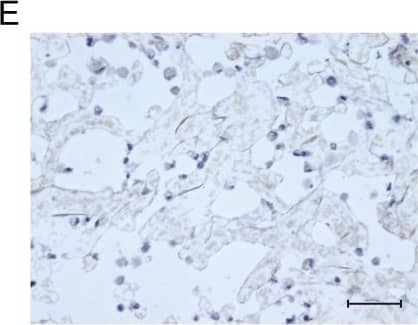 View Larger
View Larger
Detection of Human Osteocalcin by Immunocytochemistry/Immunofluorescence Nano-fiber plugs induce osteogenesis of human MSCs.Healthy donor-derived MSCs were seeded onto plastic plates (A-C) or injected into the nano-fiber plugs (D-I), and then cultured in MSCGM for 1 day (D), 7 days (E, G), 14 days (F, H) and 28 days (A-C, I). Then, the expression levels of RUNX2 (A, D, G), osteocalcin (B, E, H), and DMP-1 (C, F, I) were evaluated immunohistochemically. Representative results of three experiments are shown. (J) Healthy donor-derived MSCs were cultured in MSCGM onto plastic plates (two-dimensional) or nano-fiber plugs (three-dimensional) for 28 days. After RNA extraction, MEPE expression in the 4 groups of healthy donor-derived MSCswas evaluated by real-time PCR. *p<0.05 vs. two-dimensional culture by paired t-test. Scale bars, 50 μm. Image collected and cropped by CiteAb from the following publication (https://dx.plos.org/10.1371/journal.pone.0153231), licensed under a CC-BY license. Not internally tested by R&D Systems.
 View Larger
View Larger
Detection of Human Osteocalcin by Immunocytochemistry/Immunofluorescence Nano-fiber plugs induce osteogenesis of human MSCs.Healthy donor-derived MSCs were seeded onto plastic plates (A-C) or injected into the nano-fiber plugs (D-I), and then cultured in MSCGM for 1 day (D), 7 days (E, G), 14 days (F, H) and 28 days (A-C, I). Then, the expression levels of RUNX2 (A, D, G), osteocalcin (B, E, H), and DMP-1 (C, F, I) were evaluated immunohistochemically. Representative results of three experiments are shown. (J) Healthy donor-derived MSCs were cultured in MSCGM onto plastic plates (two-dimensional) or nano-fiber plugs (three-dimensional) for 28 days. After RNA extraction, MEPE expression in the 4 groups of healthy donor-derived MSCswas evaluated by real-time PCR. *p<0.05 vs. two-dimensional culture by paired t-test. Scale bars, 50 μm. Image collected and cropped by CiteAb from the following publication (https://dx.plos.org/10.1371/journal.pone.0153231), licensed under a CC-BY license. Not internally tested by R&D Systems.
 View Larger
View Larger
Detection of Human Osteocalcin by Immunohistochemistry TM-25659 delivery by oral gavage promotes in vivo bone formation of ADSCs. a Schematic description of the experimental procedure for in vivo transplantation. Adipose-derived stem cells (ASCs) were initially treated with osteoinductive medium for 7 consecutive days and then harvested, seeded on porous beta -TCP blocks as carriers, and subcutaneously transplanted into nude mice (six animals per experimental group). Six weeks later all transplants were harvested for further analysis. b Hematoxylin and eosin (H&E) and Masson trichrome staining revealed markedly enhanced bone formation in samples from animals treated with TM-25659 via oral gavage compared with vehicle-treated samples. Scale bar = 100 μm. c Quantification of bone formation in samples indicated significantly more bone formation in samples from animals treated with TM-25659. Ten images of Masson staining (400×) were randomly selected in the slides from two experimental groups and captured under microscopy. The area of new bone in each image was marked using ImageJ and the percentage of new bone over total area was calculated. d Immunohistochemical staining of osteopontin (OPN) and osteocalcin (OCN) in samples revealed elevated OPN and OCN abundance in samples from animals treated with TM-25659 compared with vehicle-treated samples. Scale bar = 100 μm. Data are shown as fold-change compared with vehicle-treated samples which were defined as 1.0. Data shown here are mean ± SD from two independent experiments; *P < 0.05, **P < 0.01, by Student’s t test. NB new bone, S scaffold Image collected and cropped by CiteAb from the following publication (https://pubmed.ncbi.nlm.nih.gov/29514703), licensed under a CC-BY license. Not internally tested by R&D Systems.
 View Larger
View Larger
Detection of Human Osteocalcin by Immunohistochemistry Msx1+ SSCs subset is a source of osteogenesis and closely correlates with endochondral ossification.a Schematic of the assessment of Msx1+ SSCs subset in differentiation hierarchy by Prx1-lineage tracing mice. b, c HE staining of newly formed calvarium tissues in skull bone injury at 2 weeks and 4 weeks after surgery, respectively. d–g Coronal sections of the calvarium tissues from Prx1Cre; RosatdTomato mice co-immunostained with Msx1 and Runx2 (d); Msx1 and OCN (e); Msx1 and ACAN (f); Msx1 and COL2 (g); Scale bars: low magnification: 30 μm, high magnification: 10 μm. At least three times of experiments were repeated independently. Image collected and cropped by CiteAb from the following open publication (https://pubmed.ncbi.nlm.nih.gov/36064711), licensed under a CC-BY license. Not internally tested by R&D Systems.
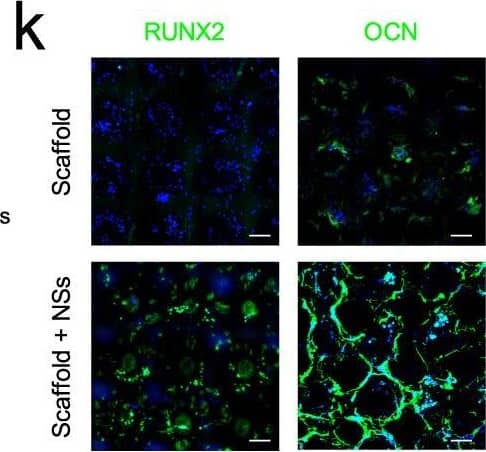 View Larger
View Larger
Detection of Human Osteocalcin by Immunohistochemistry 3D printed hydrogel scaffold with NSs enhances in vitro expansion and osteogenic potential of MSCs.a Schematic diagram of NSs-loaded 3D printing gel scaffold by DLP technology. b Bright field image of MSCs distribution and cell morphology on the surface and inside of the gel scaffold and NSs-loaded gel scaffold for 3 days and 7 days, bar = 200 μm. c Live/Dead staining (Green, live cells; Red, dead cells) of MSCs expanded on gel scaffold and NSs-loaded gel scaffold for 7 days and 14 days, bar = 50 μm. d Bright field image and Live/Dead staining (bar = 200 μm, 50μm); e Gross view and f ALP staining, bar = 100μm, Exact p value calculated with unpaired t-test: ***p = 0.0003, n = 5 biologically independent samples; g immunostaining of RUNX2 and OCN after 7 days’ osteogenic differentiation of expanded MSCs on gel scaffold after 7 days (bar = 30 μm). h Bright field image and Live/Dead staining (bar = 200 μm, 50 μm); i Gross view and j Alizarin Red S staining, bar = 100 μm, Exact p value calculated with unpaired t-test: ***p = 0.0004, n = 4 biologically independent samples; k immunostaining of RUNX2 and OCN after 14 days’ osteogenic differentiation of expanded MSCs on gel scaffold after 7 days (bar = 30 μm). Bone marrow stem cells are isolated from orthopedic individuals with written informed consent. All data represent mean ± SEM, and source data are provided as a Source Data file. At least three times of experiments were repeated independently. Image collected and cropped by CiteAb from the following open publication (https://pubmed.ncbi.nlm.nih.gov/36064711), licensed under a CC-BY license. Not internally tested by R&D Systems.
Reconstitution Calculator
Preparation and Storage
- 12 months from date of receipt, -20 to -70 °C as supplied.
- 1 month, 2 to 8 °C under sterile conditions after reconstitution.
- 6 months, -20 to -70 °C under sterile conditions after reconstitution.
Background: Osteocalcin
Osteocalcin, also known as Bone gamma -Carboxyglutamic Acid Protein, is a secreted protein whose expression is restricted to cells of the osteoblast lineage (1). It has been frequently used as a marker for osteoblast lineage cells.
Product Datasheets
Citations for Human/Rat Osteocalcin Antibody
R&D Systems personnel manually curate a database that contains references using R&D Systems products. The data collected includes not only links to publications in PubMed, but also provides information about sample types, species, and experimental conditions.
58
Citations: Showing 1 - 10
Filter your results:
Filter by:
-
Dominoes with interlocking consequences triggered by zinc: involvement of microelement-stimulated MSC-derived exosomes in senile osteogenesis and osteoclast dialogue
Authors: Shi Yin, Sihan Lin, Jingyi Xu, Guangzheng Yang, Hongyan Chen, Xinquan Jiang
J Nanobiotechnology
-
Trabecular Titanium for Orthopedic Applications: Balancing Antimicrobial with Osteoconductive Properties by Varying Silver Contents
Authors: Diez-Escudero A, Carlsson E, Andersson B et al.
ACS Applied Materials & Interfaces
-
The use of heparin/polycation coacervate sustain release system to compare the bone regenerative potentials of 5 BMPs using a critical sized calvarial bone defect model
Authors: Xueqin Gao, Mintai P. Hwang, Nathaniel Wright, Aiping Lu, Joseph J. Ruzbarsky, Matthieu Huard et al.
Biomaterials
-
Mummy Material Can Promote Differentiation of Adipose Derived Stem Cells into Osteoblast through Enhancement of Bone Specific Transcription Factors Expression
Authors: Maryam Eyvazi, Raheleh Farahzadi, Nahid Karimian Fathi, Mohammad Karimipour, Jafar Soleimani Rad, Azadeh Montaseri
Advanced Pharmaceutical Bulletin
-
Fetal Muse-based therapy prevents lethal radio-induced gastrointestinal syndrome by intestinal regeneration
Authors: Honorine Dushime, Stéphanie G. Moreno, Christine Linard, Annie Adrait, Yohann Couté, Juliette Peltzer et al.
Stem Cell Research & Therapy
-
Local nascent protein deposition and remodelling guide mesenchymal stromal cell mechanosensing and fate in three-dimensional hydrogels
Authors: Claudia Loebel, Robert L. Mauck, Jason A. Burdick
Nature Materials
-
Human Mesenchymal Stem Cell‐Derived Miniature Joint System for Disease Modeling and Drug Testing
Authors: Zhong Li, Zixuan Lin, Silvia Liu, Haruyo Yagi, Xiurui Zhang, Lauren Yocum et al.
Advanced Science
-
BMAL1-TTK-H2Bub1 loop deficiency contributes to impaired BM-MSC-mediated bone formation in senile osteoporosis
Authors: Li Jinteng, Xu Peitao, Yu Wenhui, Ye Guiwen, Ye Feng, Xu Xiaojun et al.
Molecular Therapy - Nucleic Acids
-
Promotion of Bone Formation in a Rat Osteoporotic Vertebral Body Defect Model via Suppression of Osteoclastogenesis by Ectopic Embryonic Calvaria Derived Mesenchymal Stem Cells
Authors: Yu, Y;Lee, S;Bock, M;An, SB;Shin, HE;Rim, JS;Kwon, JO;Park, KS;Han, I;
International journal of molecular sciences
Species: Rat
Sample Types: Whole Tissue
Applications: Immunohistochemistry -
Electrospun Scaffolds of Polylactic Acid, Collagen, and Amorphous Calcium Phosphate for Bone Repair
Authors: Cárdenas-Aguazaco, W;Camacho, B;Gómez-Pachón, EY;Lara-Bertrand, AL;Silva-Cote, I;
Pharmaceutics
Species: Human
Sample Types: Whole Tissue
Applications: IHC -
Mechanical and Functional Improvement of ?-TCP Scaffolds for Use in Bone Tissue Engineering
Authors: Umrath, F;Schmitt, LF;Kliesch, SM;Schille, C;Geis-Gerstorfer, J;Gurewitsch, E;Bahrini, K;Peters, F;Reinert, S;Alexander, D;
Journal of functional biomaterials
Species: Human
Sample Types: Whole Cells
-
Cholinergic-like neurons and cerebral spheroids bearing the PSEN1 p.Ile416Thr variant mirror Alzheimer's disease neuropathology
Authors: Gomez-Sequeda, N;Mendivil-Perez, M;Jimenez-Del-Rio, M;Lopera, F;Velez-Pardo, C;
Scientific reports
Species: Human
Sample Types: Whole Cells
Applications: ICC -
Role of cartilage and bone matrix regulation in early equine osteochondrosis
Authors: SK Grissom, SA Semevolos, K Duesterdie
Bone Reports, 2023-01-05;18(0):101653.
Species: Equine
Sample Types: Whole Tissue
Applications: IHC -
CTR9 drives osteochondral lineage differentiation of human mesenchymal stem cells via epigenetic regulation of BMP-2 signaling
Authors: NT Chan, MS Lee, Y Wang, J Galipeau, WJ Li, W Xu
Science Advances, 2022-11-16;8(46):eadc9222.
Species: Human
Sample Types: Transduced Whole Cells
Applications: ICC -
Trabecular Titanium for Orthopedic Applications: Balancing Antimicrobial with Osteoconductive Properties by Varying Silver Contents
Authors: Diez-Escudero A, Carlsson E, Andersson B et al.
ACS Applied Materials & Interfaces
-
Msx1+ stem cells recruited by bioactive tissue engineering graft for bone regeneration
Authors: X Zhang, W Jiang, C Xie, X Wu, Q Ren, F Wang, X Shen, Y Hong, H Wu, Y Liao, Y Zhang, R Liang, W Sun, Y Gu, T Zhang, Y Chen, W Wei, S Zhang, W Zou, H Ouyang
Nature Communications, 2022-09-05;13(1):5211.
Species: Rat
Sample Types: Whole Tissue
Applications: IHC -
The use of heparin/polycation coacervate sustain release system to compare the bone regenerative potentials of 5 BMPs using a critical sized calvarial bone defect model
Authors: Xueqin Gao, Mintai P. Hwang, Nathaniel Wright, Aiping Lu, Joseph J. Ruzbarsky, Matthieu Huard et al.
Biomaterials
Species: Mouse
Sample Types: Spheroid
Applications: Immunohistochemistry -
Circulating Osteogenic Progenitor Cells Enhanced with Teriparatide or Denosumab Treatment
Authors: M Giner, MA Vázquez-Gá, MJ Miranda, J Bocio-Nuñe, FJ Olmo-Monte, MA Rico, MA Colmenero, MJ Montoya-Ga
Journal of Clinical Medicine, 2022-08-14;11(16):.
Species: Human
Sample Types: Whole Cells
Applications: Flow Cytometry -
Highly elastic and bioactive bone biomimetic scaffolds based on platelet lysate and biomineralized cellulose nanocrystals
Authors: JP Ribeiro, RMA Domingues, PS Babo, LP Nogueira, JE Reseland, RL Reis, M Gomez-Flor, ME Gomes
Carbohydrate polymers, 2022-05-20;292(0):119638.
Species: Human
Sample Types: Whole Tissue
Applications: IHC -
Comparison between hydroxyapatite and polycaprolactone in inducing osteogenic differentiation and augmenting maxillary bone regeneration in rats
Authors: NA Luchman, R Megat Abdu, SH Zainal Ari, NS Nasruddin, SF Lau, F Yazid
PeerJ, 2022-05-02;10(0):e13356.
Species: Rat
Sample Types: Whole Tissue
Applications: IHC -
Enamel Matrix Derivative Enhances the Odontoblastic Differentiation of Dental Pulp Stem Cells via Activating MAPK Signaling Pathways
Authors: B Zhang, M Xiao, X Cheng, Y Bai, H Chen, Q Yu, L Qiu
Stem Cells International, 2022-04-28;2022(0):2236250.
Species: Mouse
Sample Types: Whole Tissue
Applications: IHC -
BMP-2 Enhances Osteogenic Differentiation of Human Adipose-Derived and Dental Pulp Stem Cells in 2D and 3D In Vitro Models
Authors: S Martin-Igl, L Milian, M Sancho-Tel, R Salvador-C, JJ Martín de, C Carda, M Mata
Stem Cells International, 2022-03-04;2022(0):4910399.
Species: Human
Sample Types: Whole Cells
Applications: ICC -
Adipocytes disrupt the translational programme of acute lymphoblastic leukaemia to favour tumour survival and persistence
Authors: Q Heydt, C Xintaropou, A Clear, M Austin, I Pislariu, F Miraki-Mou, P Cutillas, K Korfi, M Calaminici, W Cawthorn, K Suchacki, A Nagano, JG Gribben, M Smith, JD Cavenagh, H Oakervee, A Castleton, D Taussig, B Peck, A Wilczynska, L McNaughton, D Bonnet, F Mardakheh, B Patel
Nature Communications, 2021-09-17;12(1):5507.
Species: Human
Sample Types: Whole Cells
Applications: ICC/IF -
Microenvironment Influences on Human Umbilical Cord Mesenchymal Stem Cell-Based Bone Regeneration
Authors: L E, R Lu, J Sun, H Li, W Xu, H Xing, X Wang, T Cheng, S Zhang, X Ma, R Zhang, H Liu
Stem Cells International, 2021-08-17;2021(0):4465022.
Species: Human
Sample Types: Whole Cells
Applications: ICC -
MicroRNA-27b targets CBFB to inhibit differentiation of human bone marrow mesenchymal stem cells into hypertrophic chondrocytes
Authors: S Lv, J Xu, L Chen, H Wu, W Feng, Y Zheng, P Li, H Zhang, L Zhang, G Chi, Y Li
Stem Cell Res Ther, 2020-09-11;11(1):392.
Species: Rat
Sample Types: Whole Tissue
Applications: IHC -
Stabilization of heterochromatin by CLOCK promotes stem cell rejuvenation and cartilage regeneration
Authors: C Liang, Z Liu, M Song, W Li, Z Wu, Z Wang, Q Wang, S Wang, K Yan, L Sun, T Hishida, Y Cai, JCI Belmonte, P Guillen, P Chan, Q Zhou, W Zhang, J Qu, GH Liu
Cell Res., 2020-07-31;0(0):.
Species: Human
Sample Types: Whole Cells
Applications: ICC -
Icaritin promotes the osteogenesis of bone marrow mesenchymal stem cells via the regulation of sclerostin expression
Authors: Qiushi Wei, Bin Wang, Hailan Hu, Chuhai Xie, Long Ling, Jianliang Gao et al.
International Journal of Molecular Medicine
Species: Human
Sample Types: Cell Lysates
Applications: Western Blot -
The combinatory effect of sinusoidal electromagnetic field and VEGF promotes osteogenesis and angiogenesis of mesenchymal stem cell-laden PCL/HA implants in a rat subcritical cranial defect
Authors: J Chen, C Tu, X Tang, H Li, J Yan, Y Ma, H Wu, C Liu
Stem Cell Res Ther, 2019-12-16;10(1):379.
Species: Rat
Sample Types: Whole Cells
Applications: ICC -
Osteoblasts are "educated" by crosstalk with metastatic breast cancer cells in the bone tumor microenvironment
Authors: AD Kolb, AB Shupp, D Mukhopadhy, FC Marini, KM Bussard
Breast Cancer Res., 2019-02-27;21(1):31.
Species: Human
Sample Types: Whole Cells, Whole Tissue
Applications: ICC, IHC-P -
Comparison of Immunosuppressive and Angiogenic Properties of Human Amnion-Derived Mesenchymal Stem Cells between 2D and 3D Culture Systems
Authors: V Miceli, M Pampalone, S Vella, AP Carreca, G Amico, PG Conaldi
Stem Cells Int, 2019-02-18;2019(0):7486279.
Species: Human
Sample Types: Whole Cells
Applications: ICC -
Differential expression patterns of Toll Like Receptors and Interleukin-37 between calcific aortic and mitral valve cusps in humans
Authors: A Kapelouzou, C Kontogiann, DI Tsilimigra, G Georgiopou, L Kaklamanis, L Tsourelis, DV Cokkinos
Cytokine, 2019-02-01;116(0):150-160.
Species: Human
Sample Types: Whole Tissue
Applications: IHC -
Influences of donor and host age on human muscle-derived stem cell-mediated bone regeneration
Authors: X Gao, A Lu, Y Tang, J Schneppend, AB Liebowitz, AC Scibetta, ER Morris, H Cheng, C Huard, S Amra, B Wang, MA Hall, WR Lowe, J Huard
Stem Cell Res Ther, 2018-11-21;9(1):316.
Species: Human
Sample Types: Whole Tissue
Applications: IHC-Fr -
Pharmacological activation of TAZ enhances osteogenic differentiation and bone formation of adipose-derived stem cells
Authors: Y Zhu, Y Wu, J Cheng, Q Wang, Z Li, Y Wang, D Wang, H Wang, W Zhang, J Ye, H Jiang, L Wang
Stem Cell Res Ther, 2018-03-07;9(1):53.
Species: Human
Sample Types: Whole Tissue
Applications: IHC -
A biomaterials approach to influence stem cell fate in injectable cell-based therapies
Authors: MH Amer, FRAJ Rose, KM Shakesheff, LJ White
Stem Cell Res Ther, 2018-02-21;9(1):39.
Species: Human
Sample Types: Whole Cells
Applications: ICC -
Rapid Rapamycin-Only Induced Osteogenic Differentiation of Blood-Derived Stem Cells and Their Adhesion to Natural and Artificial Scaffolds
Authors: C Arianna, C Eliana, A Flavio, R Marco, D Giacomo, S Manuel, B Elena, G Alessandra
Stem Cells Int, 2017-07-26;2017(0):2976541.
Species: Human
Sample Types: Whole Cells
Applications: ICC -
Identification of multipotent stem cells in human brain tissue following stroke
Authors: K Tatebayash, Y Tanaka, A Nakano-Doi, R Sakuma, S Kamachi, M Shirakawa, K Uchida, H Kageyama, T Takagi, S Yoshimura, T Matsuyama, T Nakagomi
Stem Cells Dev, 2017-04-19;0(0):.
Species: Human
Sample Types: Whole Cells
Applications: ICC -
Collagen type XV and the 'osteogenic status'
Authors: G Lisignoli, E Lambertini, C Manferdini, E Gabusi, L Penolazzi, F Paolella, M Angelozzi, V Casagranda, R Piva
J. Cell. Mol. Med, 2017-03-22;0(0):.
Species: Human
Sample Types: Whole Cells
Applications: Flow Cytometry -
25-Hydroxyvitamin D3 induces osteogenic differentiation of human mesenchymal stem cells
Authors: YR Lou, TC Toh, YH Tee, H Yu
Sci Rep, 2017-02-17;7(0):42816.
Species: Human
Sample Types: Whole Cells
Applications: ICC -
Transcriptome sequencing wide functional analysis of human mesenchymal stem cells in response to TLR4 ligand
Sci Rep, 2016-07-22;6(0):30311.
Species: Human
Sample Types: Whole Cells
Applications: IHC -
Immobilized WNT Proteins Act as a Stem Cell Niche for Tissue Engineering
Stem Cell Reports, 2016-07-12;7(1):126-37.
Species: Human
Sample Types: Whole Cells
Applications: IHC -
Ultra-Porous Nanoparticle Networks: A Biomimetic Coating Morphology for Enhanced Cellular Response and Infiltration
Authors: N Nasiri, A Ceramidas, S Mukherjee, A Panneersel, DR Nisbet, A Tricoli
Sci Rep, 2016-04-14;6(0):24305.
Species: Mouse
Sample Types: Whole Cells
Applications: IHC-Fr -
PDL regeneration via cell homing in delayed replantation of avulsed teeth.
Authors: Zhu W, Zhang Q, Zhang Y, Cen L, Wang J
J Transl Med, 2015-11-14;13(0):357.
Species: Canine
Sample Types: Whole Tissue
Applications: IHC-P -
Gene expression profile analysis of human mesenchymal stem cells from herniated and degenerated intervertebral discs reveals different expression of osteopontin.
Authors: Marfia G, Navone S, Di Vito C, Tabano S, Giammattei L, Di Cristofori A, Gualtierotti R, Tremolada C, Zavanone M, Caroli M, Torchia F, Miozzo M, Rampini P, Riboni L, Campanella R
Stem Cells Dev, 2014-10-29;24(3):320-8.
Species: Human
Sample Types: Whole Cells
Applications: ICC -
Primary osteoblast-like cells from patients with end-stage kidney disease reflect gene expression, proliferation, and mineralization characteristics ex vivo.
Authors: Pereira R, Delany A, Khouzam N, Bowen R, Freymiller E, Salusky I, Wesseling-Perry K
Kidney Int, 2014-10-29;87(3):593-601.
Species: Human
Sample Types: Whole Cells
Applications: IHC -
Identification of a cell-of-origin for fibroblasts comprising the fibrotic reticulum in idiopathic pulmonary fibrosis.
Authors: Xia H, Bodempudi V, Benyumov A, Hergert P, Tank D, Herrera J, Braziunas J, Larsson O, Parker M, Rossi D, Smith K, Peterson M, Limper A, Jessurun J, Connett J, Ingbar D, Phan S, Bitterman P, Henke C
Am J Pathol, 2014-03-13;184(5):1369-83.
Species: Human
Sample Types: Whole Cells
Applications: IHC -
Bone matrix, cellularity, and structural changes in a rat model with high-turnover osteoporosis induced by combined ovariectomy and a multiple-deficient diet.
Authors: Govindarajan P, Bocker W, El Khassawna T, Kampschulte M, Schlewitz G, Huerter B, Sommer U, Durselen L, Ignatius A, Bauer N, Szalay G, Wenisch S, Lips K, Schnettler R, Langheinrich A, Heiss C
Am J Pathol, 2013-12-31;184(3):765-77.
Species: Rat
Sample Types: Whole Tissue
Applications: IHC -
Derivation and expansion using only small molecules of human neural progenitors for neurodegenerative disease modeling.
Authors: Reinhardt P, Glatza M, Hemmer K, Tsytsyura Y, Thiel C, Hoing S, Moritz S, Parga J, Wagner L, Bruder J, Wu G, Schmid B, Ropke A, Klingauf J, Schwamborn J, Gasser T, Scholer H, Sterneckert J
PLoS ONE, 2013-03-22;8(3):e59252.
Species: Human
Sample Types: Whole Cells
Applications: ICC -
Dilatational band formation in bone.
Authors: Poundarik, Atharva, Diab, Tamim, Sroga, Grazyna, Ural, Ani, Boskey, Adele L, Gundberg, Caren M, Vashishth, Deepak
Proc Natl Acad Sci U S A, 2012-11-05;109(47):19178-83.
Species: Human
Sample Types: Whole Tissue
Applications: IHC -
Age-related changes in rat bone-marrow mesenchymal stem cell plasticity.
Authors: Asumda FZ, Chase PB
BMC Cell Biol., 2011-10-12;12(0):44.
Species: Rat
Sample Types: Whole Cells
Applications: ICC -
The guidance of human mesenchymal stem cell differentiation in vitro by controlled modifications to the cell substrate.
Authors: Curran JM, Chen R, Hunt JA
Biomaterials, 2006-06-02;27(27):4783-93.
Species: Human
Sample Types: Whole Cells
Applications: ICC -
A hybrid coating of biomimetic apatite and osteocalcin.
Authors: Krout A, Wen HB, Hippensteel E, Li P
J Biomed Mater Res A, 2005-06-15;73(4):377-87.
Species: Rat
Sample Types: Whole Tissue
Applications: IHC -
TRPM8 channel inhibitor-encapsulated hydrogel as a tunable surface for bone tissue engineering
Authors: Acharya TK, Kumar S, Tiwari N et al.
Scientific reports
-
The Effects of Mechanical Stimulation on Controlling and Maintaining Marrow Stromal Cell Differentiation Into Vascular Smooth Muscle Cells
Authors: Raphael Yao, Joyce Y. Wong
Journal of Biomechanical Engineering
-
Peroxisomes in Different Skeletal Cell Types during Intramembranous and Endochondral Ossification and Their Regulation during Osteoblast Differentiation by Distinct Peroxisome Proliferator-Activated Receptors.
Authors: Qian G, Fan W, Ahlemeyer B, Karnati S, Baumgart-Vogt E
PLoS ONE, 2015-12-02;10(12):e0143439.
-
Digital Light Processing 3D Printing of Gyroid Scaffold with Isosorbide-Based Photopolymer for Bone Tissue Engineering
Authors: Fiona Verisqa, Jae-Ryung Cha, Linh Nguyen, Hae-Won Kim, Jonathan C. Knowles
Biomolecules
-
Serum and tissue biomarkers in aortic stenosis
Authors: Alkistis Kapelouzou, Loukas Tsourelis, Loukas Kaklamanis, Dimitrios Degiannis, Nektarios Kogerakis, Dennis V. Cokkinos
Global Cardiology Science and Practice
-
Differentiation of human neuroblastoma cells toward the osteogenic lineage by mTOR inhibitor
Authors: A Carpentieri, E Cozzoli, M Scimeca, E Bonanno, A M Sardanelli, A Gambacurta
Cell Death & Disease
-
Icaritin promotes the osteogenesis of bone marrow mesenchymal stem cells via the regulation of sclerostin expression
Authors: Qiushi Wei, Bin Wang, Hailan Hu, Chuhai Xie, Long Ling, Jianliang Gao et al.
International Journal of Molecular Medicine
FAQs
No product specific FAQs exist for this product, however you may
View all Antibody FAQsReviews for Human/Rat Osteocalcin Antibody
Average Rating: 5 (Based on 1 Review)
Have you used Human/Rat Osteocalcin Antibody?
Submit a review and receive an Amazon gift card.
$25/€18/£15/$25CAN/¥75 Yuan/¥2500 Yen for a review with an image
$10/€7/£6/$10 CAD/¥70 Yuan/¥1110 Yen for a review without an image
Filter by:
